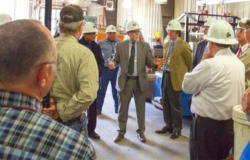Workers to re-enter WIPP
10 March 2014
A recovery process has started at the Waste Isolation Pilot Plant (WIPP) with the aim of resuming operations. Seventeen workers have so far tested positive for extremely low levels of contamination following a radiological event at the facility last month.
 |
| DoE officials recently visited WIPP to observe site recovery activities (Image: DoE) |
The WIPP plant in New Mexico is owned by the US Department of Energy (DoE) and operated by Nuclear Waste Partnership LLC (NWP). The facility disposes of transuranic waste packages from the US military in an underground salt formation. An underground monitor detected airborne radiation within the plant on 14 February.
The DoE and NWP have lowered radiological and air quality instruments down the salt handling and air intake shafts at WIPP. They said that preliminary findings show no detectable radioactive contamination in the air or on the equipment lowered and returned to the surface. Air quality results were also found to be normal. However, "these results were expected because the shafts that were sampled were not in the air flow path coming from the area where the radiation release originated," a joint statement read.
NWP's WIPP recovery process manager Tammy Reynolds commented, "This process is critical in helping determine the proper personal protection equipment needed for our personnel entries. We will do a final analysis of these samples before we send anyone down."
A team of workers may be sent into the underground facility "as soon as the end of the week ... to characterize the mine's stability and attempt to identify the source of the release," DoE and NWP said. Once identified, the team will isolate the source and "implement a plan to remove the contamination hazard."
Worker contamination
There were no workers underground at the time but, as a precautionary measure, all those at the surface were checked for external contamination. Filters on the underground plant's vents removed at least 99.87% of contaminants from the air, but trace amounts of americium and plutonium were subsequently detected by an above-ground sampling station near the plant. Since the event, only essential staff have been allowed on site and no shipments of waste have been delivered to the plant.
So far, tests on 17 workers have indicated "extremely low" contamination. As no detectable contamination has been found in urine samples, it is assumed that the contamination was not inhaled into the lungs.
The DoE and NWP stressed that as the levels of exposure are so low - just above background levels - none of the workers is expected to experience any health effects.
Air sampling data continues to show that no significant contamination has been found offsite.
Researched and written
by World Nuclear News